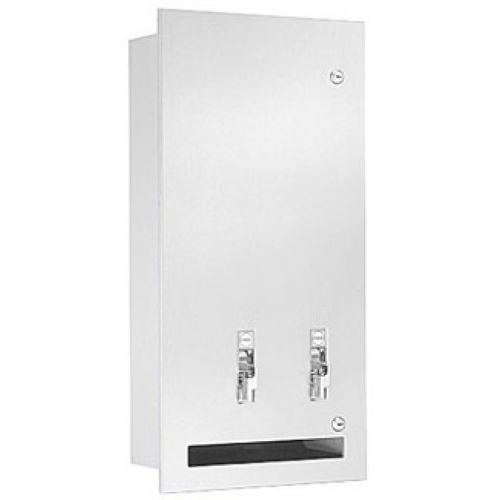
BC-4017-40 4017 Sanitary Napkin Tampon Vendor with Free Mech
Bradley Restroom Accessory
BC-4017-40Recessed combination napkin/tampon vendor fabricated of 22 gauge stainless steel with exposed surfaces in satin finish. Cabinet door has full-length piano hinge and two tumbler locks. Two coin mechanisms permit dispensing thirty napkins and twenty-eight tampons and be available with free, $.10, $.25, $.50, $1.00 denomination.
Downloads Specification Sheet for BC-4017-40

BC-4017-40 4017 Sanitary Napkin Tampon Vendor with Free Mech
|
SKU
|
Description
|
Quantity
|
|
|---|---|---|---|
|
|
More Info
Stainless Steel Cleaning and Maintenance:
Stainless steel is a low-carbon steel that contains at least 10 percent chromium. The addition of chromium gives the steel its unique corrosion-resisting properties. Most Bradley accessories are fabricated from type 304 stainless steel, which contains 18 percent chromium and 8 percent nickel. Bradley uses it because it is extremely durable, resists corrosion, stands up to many chemicals, and is easy to fabricate.
Stainless steels are very resistant to rust, however this does not mean that they are impervious to it. Stainless steel must be kept clean and free from contaminants. Frequent cleaning with mild soap and water or glass cleaner and a cotton cloth is required. Sometimes stainless steel products will develop corrosion or discoloration due to environmental and installation conditions. The following is a list of common conditions that cause corrosion or discoloration of stainless steel and should be avoided:
- Chloride containing cleansers - this includes bleach and any bleach containing cleaners
- Muriatic acid (hydrochloric acid) - commonly used to clean up after tile/concrete installation
- Concentrated soap residue - chemical additives will cause discoloration and some dried soaps actually look like rust
- Water with high iron content - can leave a rusty residue, especially if allowed to drip continuously
- Contact with iron materials - including steel wool, machining chips, and iron residue/dust from installation or cleaning of other steel products
- Trapped moisture between the product and another object - rubber mats, metal cans of soaps or cleaners
- Salts - contain chlorides
Any discoloration or corrosion should be removed as soon as possible, or permanent discoloration and pitting of the surface could occur. Usually, the product can be restored to its original condition. Most discoloration can be removed with a mild cleanser (Ajax, Bon Ami, etc.) or stainless steel cleaner (Revere Ware Stainless Steel Cleaner, Goddard's Stainless Steel Cleaner, etc.) and a Scotchbrite pad. The surface should then be thoroughly rinsed with clear water. With proper maintenance, stainless steel will maintain its luster and appearance indefinitely.




